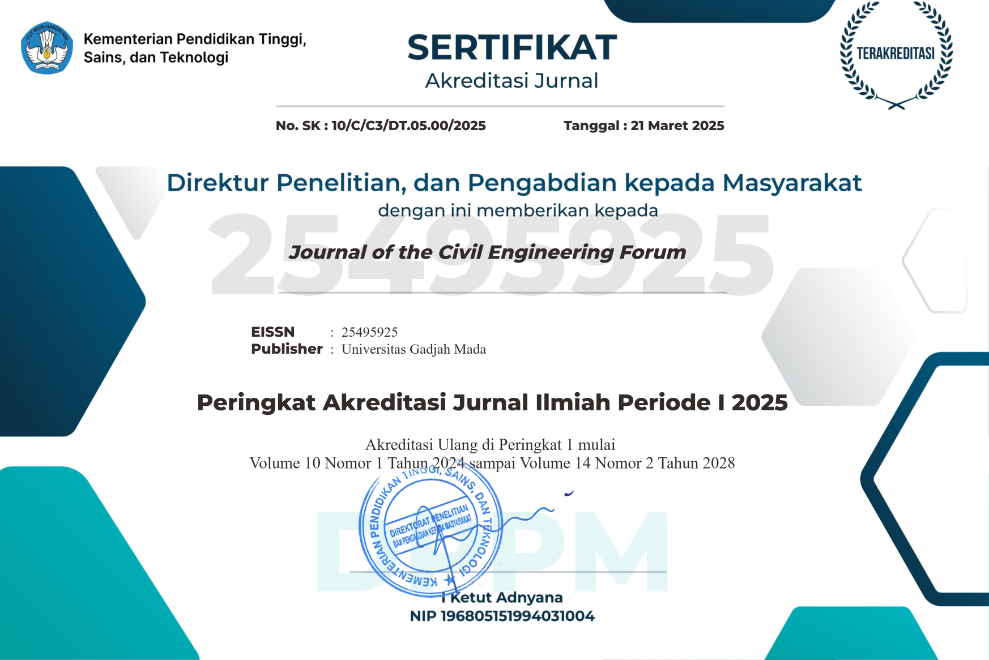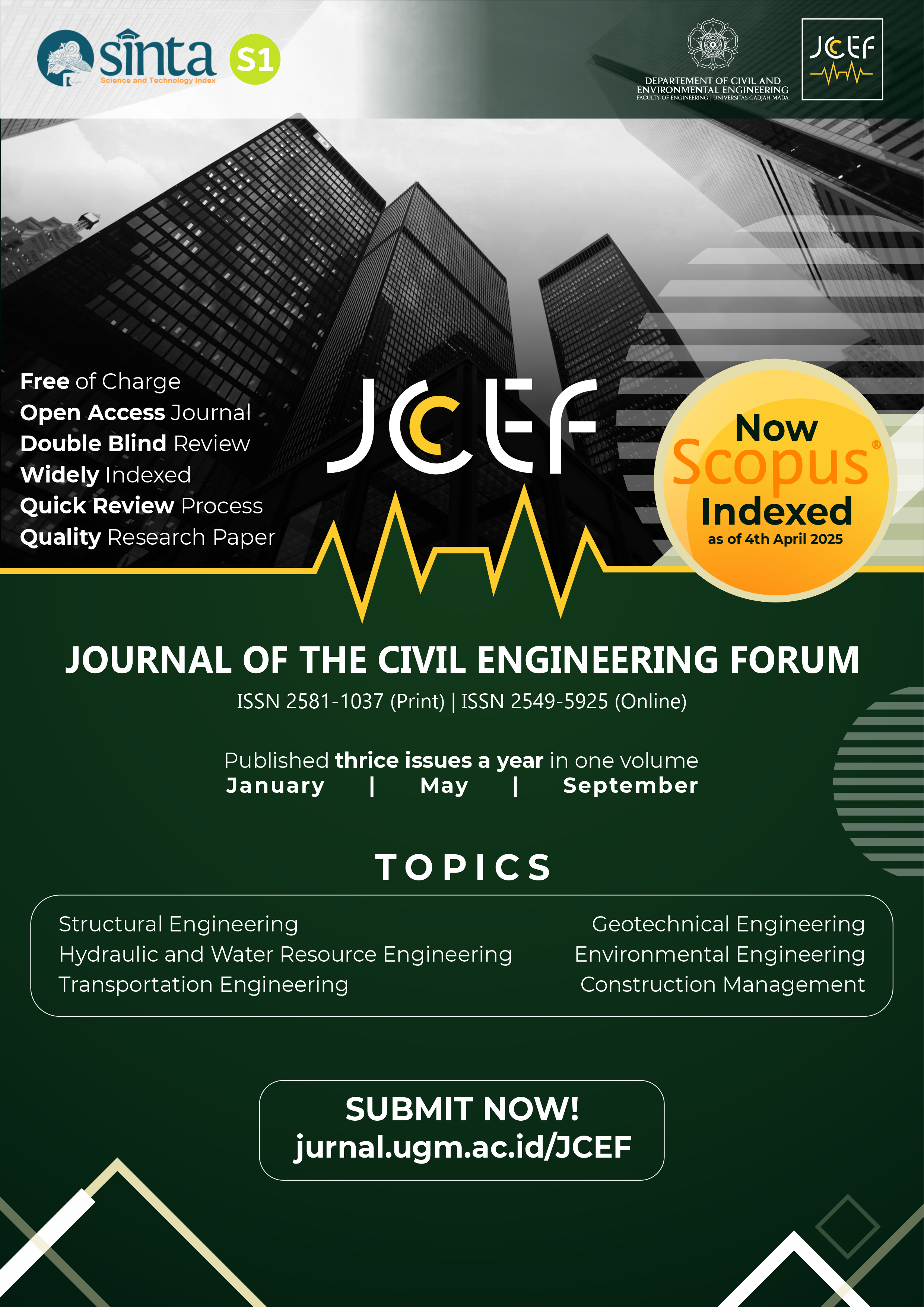Transformation of Geospatial Modelling of Soil Erosion Susceptibility Using Machine Learning
Abstract
Soil erosion presents substantial environmental and economic challenges, especially in areas prone to land degradation. This study assesses the use of Machine Learning (ML) methods—Support Vector Machines (SVM) and Generalized Linear Models (GLM)—to model Soil Erosion Susceptibility (SES) in the Saddang Watershed, Indonesia. It incorporates environmental, hydrological, and topographical factors to improve prediction accuracy. The approach includes multi-source geospatial data collection, erosion inventory mapping, and relevant factor selection. SVM and GLM were applied to classify SES, with performance evaluated using accuracy, AUC, and precision metrics. Results show SVM classified 40.59% of the area as moderately susceptible and 38.50% as low susceptibility. GLM identified 24.55% as very low and 38.59% as low susceptibility. Both models demonstrated high accuracy (SVM: 87.4%, GLM: 87.2%) and strong AUC values (SVM: 0.916, GLM: 0.939), though GLM showed better specificity and recall. Feature importance analysis highlights that GLM favors hydrological factors like river proximity and drainage density, while SVM balances across various environmental inputs. These findings affirm the value of ML-based geospatial modeling for SES assessment, supporting interventions such as reforestation and erosion control. SVM is suitable for localized planning, whereas GLM offers strategic-level insights. This research contributes to advancing environmental modeling by embedding domain knowledge into ML frameworks, and suggests future work integrate real-time remote sensing and more sophisticated models for broader SES prediction.
References
Olii, M. R., Olii, A. K. Z., Olii, A., Pakaya, R. and Kironoto, B. A. (2024), ‘Spatial modeling of soil erosion risk: a multi-criteria decisionmaking (mcdm) approach in the paguyaman watershed, gorontalo, indonesia’, Arabian Journal of Geosciences 17(226), 1–13.
Al-Bawi, A. J., Al-Abadi, A. M., Pradhan, B. and Alamri, A. M. (2021), ‘Assessing gully erosion susceptibility using topographic derived attributes, multi-criteria decision-making, and machine learning classifiers’, Geomatics, Natural Hazards and Risk 12(1), 3035–3062.
Almouctar, M. A. S., Wu, Y., Zhao, F. and Dossou, J. F. (2021), ‘Soil erosion assessment using the rusle model and geospatial techniques (remote sensing and gis) in south-central niger (maradi region)’, Water (Switzerland) 13(24).
Arabameri, A., Cerda, A. and Tiefenbacher, J. P. (2019), ‘Spatial pattern analysis and prediction of gully erosion using novel hybrid model of entropy-weight of evidence’, Water (Switzerland) 11(6), 1–23.
Arabameri, A., Pradhan, B., Pourghasemi, H. R. and Rezaei, K. (2018), ‘Identification of erosion-prone areas using different multi-criteria decision-making techniques and gis’, Geomatics, Natural Hazards and Risk 9(1), 1129–1155.
Band, S. S. et al. (2020), ‘Novel ensemble approach of deep learning neural network (dlnn) model and particle swarm optimization (pso) algorithm for prediction of gully erosion susceptibility’, Sensors (Switzerland) 20(19), 1–28.
Bui, D. T., Tsangaratos, P., Nguyen, V. T., Van, N. and Trinh, P. T. (2020), ‘Comparing the prediction performance of a deep learning neural network model with conventional machine learning models in landslide susceptibility assessment’, Catena 188, 104426.
Devos, O., Ruckebusch, C., Durand, A., Duponchel, L. and Huvenne, J. P. (2009), ‘Support vector machines (svm) in near infrared (nir) spectroscopy: Focus on parameters optimization and model interpretation’, Chemometrics and Intelligent Laboratory Systems 96(1), 27–33.
Eekhout, J. P. C. and de Vente, J. (2022), ‘Global impact of climate change on soil erosion and potential for adaptation through soil conservation’, Earth-Science Reviews 226, 103921.
Farhan, Y., Zregat, D. and Farhan, I. (2013), ‘Spatial estimation of soil erosion risk using rusle approach, rs, and gis techniques: A case study of kufranja watershed, northern jordan’, Journal of Water Resource and Protection 5(12), 1247–1261.
Gayen, A., Pourghasemi, H. R., Saha, S., Keesstra, S. and Bai, S. (2019), ‘Gully erosion susceptibility assessment and management of hazardprone areas in india using different machine learning algorithms’, Science of the Total Environment 668, 124–138.
Golijanin, J. et al. (2022), ‘Estimation of potential soil erosion reduction using gis-based rusle under different land cover management models: A case study of pale municipality, b&h’, Frontiers in Environmental Science 10(August), 1–13.
Golkarian, A., Khosravi, K., Panahi, M. and Clague, J. J. (2023), ‘Spatial variability of soil water erosion: Comparing empirical and intelligent techniques’, Geoscience Frontiers 14(1), 101456.
Huang, D., Su, L., Zhou, L., Tian, Y. and Fan, H. (2023), ‘Assessment of gully erosion susceptibility using different dem-derived topographic factors in the black soil region of northeast china’, International Soil and Water Conservation Research 11(1), 97–111.
Igwe, O., John, U. I., Solomon, O. and Obinna, O. (2020), ‘Gis-based gully erosion susceptibility modeling, adapting bivariate statistical method and ahp approach in gombe town and environs northeast nigeria’, Geoenvironmental Disasters 7(1).
Kucuker, D. M. and Giraldo, D. C. (2022), ‘Assessment of soil erosion risk using an integrated approach of gis and analytic hierarchy process (ahp) in erzurum, turkiye’, Ecological Informatics 71, 101788.
Mosavi, A., Sajedi-Hosseini, F., Choubin, B., Taromideh, F., Rahi, G. and Dineva, A. A. (2020), ‘Susceptibility mapping of soil water erosion using machine learning models’, Water (Switzerland) 12(7).
Mustafa, M. R. U., Sholagberu, A. T., Yusof, K. W., Hashim, A. M., Khan, M. W. A. and Shahbaz, M. (2018), Svm-based geospatial prediction of soil erosion under static and dynamic conditioning factors, in ‘MATEC Web of Conferences’, Vol. 203.
Olii, M. R., Kironoto, B. A., Olii, A., Pakaya, R. and Olii, A. K. Z. (2024), Advancing soil erosion assessment: Application of remote sensing and geospatial techniques in bulango ulu reservoir basin, in ‘E3S Web of Conferences’, Vol. 476, pp. 1–15.
Olii, M. R., Olii, A., Pakaya, R. and Olii, M. Y. U. P. (2023), ‘Gis-based analytic hierarchy process (ahp) for soil erosion-prone areas mapping in the bone watershed, gorontalo, indonesia’, Environmental Earth Sciences 82(9), 1–14.
Phinzi, K. and Szabó, S. (2024), Predictive machine learning for gully susceptibility modeling with geoenvironmental covariates: main drivers, model performance, and computational efficiency, Vol. 120, Springer Netherlands.
Pourghasemi, H. R., Sadhasivam, N., Kariminejad, N. and Collins, A. L. (2020), ‘Gully erosion spatial modelling: Role of machine learning algorithms in selection of the best controlling factors and modelling process’, Geoscience Frontiers 11(6), 2207–2219.
Rahmati, O., Tahmasebipour, N., Haghizadeh, A., Pourghasemi, H. R. and Feizizadeh, B. (2017), ‘Evaluating the influence of geo-environmental factors on gully erosion in a semi-arid region of iran: An integrated framework’, Science of the Total Environment 579, 913–927.
Riley, S. J., DeGloria, S. D. and Elliot, R. (1999), ‘A terrain ruggedness index that quantifies topographic heterogeneity’, Intermountain Journal of Sciences 5(1–4), 23–27.
Saini, S. S., Jangra, R. and Kaushik, S. P. (2015), ‘Vulnerability assessment of soil erosion using geospatial techniques-a pilot study of upper catchment of markanda river’, International Journal of Advanced Remote Sensing 3(1), 9–21.
Vu Dinh, T., Hoang, N. D. and Tran, X. L. (2021), ‘Evaluation of different machine learning models for predicting soil erosion in tropical sloping lands of northeast vietnam’, Applied and Environmental Soil Science pp. 1–14.
Copyright (c) 2025 The Author(s)

This work is licensed under a Creative Commons Attribution-ShareAlike 4.0 International License.
Copyright is granted to authors for the purpose of providing protection for articles written to describe experiments and their results. JCEF will protect and defend the work and reputation of the author and are also willing to address any allegations of violation, plagiarism, fraud, etc. against articles written and published by JCEF. JCEF is published under the terms of the Creative Commons Attribution-ShareAlike 4.0 International License (CC BY-SA 4.0). The author holds the copyright and assigns the journal rights to the first publication (online and print) of the work simultaneously.







